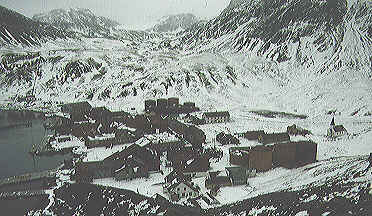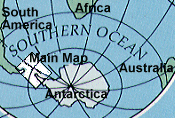|
From a distance Grytviken looks like a small, peaceful,
Norwegian town set deep inside a fjord. By 2030 on Feb 1, after a
days sail up the coast of South Georgia, Pelagic is tied to the
jetty of this once busy town. From afar everthing has an
appearance of order and neatness, but a closer look reveals a
different reality. Apart from the building, once called the "Villa",
which housed the directors of the whaling station and is now the
Grytviken Museum, everything is in ruin.
Today Grytviken is the ghost town of what was a bustling whaling
station with a population of 500 hard working men. The history of
South Georgia is largely the history of whales and men.

Grytviken
Today
click for full size image
Grytvikens literal translation is 'pot cove' and is named after
the 2 big iron "Trypots" found by a Swedish expedition
on the foreshore in 1902. "Trying out" means boiling
down and was the process used to render seal blubber. The town was
established by the pioneer of whaling in the Antarctic, a
Norwegian, Captain C.A. Larsen.
In 1904, he formed the Compania Argentina de Pesca with
Argentine investment, and came to lay the foundations of the
whaling industry in what he considered the safest harbour of South
Georgia. Larsen sailed on various ships to the Antarctic but is
particularly famous for having been the captain of the Swedish
expedition ship 'Antarctic', used by Otto Nordenskjold. This ship,
like Shackletons 'Endurance,' was trapped and crushed by ice in
the Weddell Sea and Larsens crew was rescued after protracted
hardships.
Larsen arrived in Grytviken on a ship with 11 crew, 65 other
men, the prefabricated plant for the whaling station and the
worker's accomodation. These men were the first 'permanent'
settlers of South Georgia. The whaling operations were an
immediate success as whales were abundant in the bays and close
inshore. As a result, within the first few years, investors were
being paid 50% dividends. Grytviken lays claim to the largest blue
whale harpooned on record. That was in 1912, during the height of
the industry. The whale measured 112 feet and was estimated to
weigh over 100 tons.
Mainly Norwegian managed, the station operated for 60 years
catching blue, fin, sei and sperm whales. The blubber was made
into precious oil, margarine, soap and glycerine for the war
industry. Subsequently the meat, bones, viscera and the whole
carcass were exploited. In the beginning, whale catches were made
in the bay in front of the town, but as the whale population
around South Georgia was depleted, the whalers had to go up to 250
miles at sea, in order to secure a catch.
Grytviken station was virtually self-sufficient. Every spring
transport ships brought the materials for the summers season's
whaling; provisions for the men and the essential coal, later fuel
oil, to fire the steam boilers. These boilers powered everything
including bone saws, hauling winches, blubber boilers, skinners
and drive shafts for the machine shops. When in full operation the
bay was filled with clouds of foul smelling vapour and smoke. The
town was a true entity, with foundries, blacksmiths, laboratories,
a hospital, a hydroelectric power station, a church, a cinema, and
even a ski jump for recreation. Pigs and chickens were raised.
Larsen also introduced reindeer for food and hunting which have
successfully reproduced on the island. The only women permitted on
the station were the wives of the managers, and alcohol was
prohibited. A trade union was formed in 1910 and strikes followed.
Captain Larsen became a dual British and Norwegian citizen and
left the island as a rich man in 1914.
Whaling ended at Grytviken in 1965, because inshore whale
stocks had become fished out. The development of the offshore
'factory ship' some years before, also contributed to the
abandonment of the town . Grytviken became front page news once
more- although only for a few months- when Argentine forces
occupied South Georgia on 3 April 1982, at the beginning of the
Falklands War. The island was recaptured by British forces 3 weeks
later. Grytviken is now inhabited by a British army garrison, a
civilian harbour, and post, master Pat Lurcock and travellers
Pauline and Tim Carr who run the museum and supervise the
preservation of the station. I'll tell you about them in the next
story.
Elena Caputo

|

![]()
![]()




